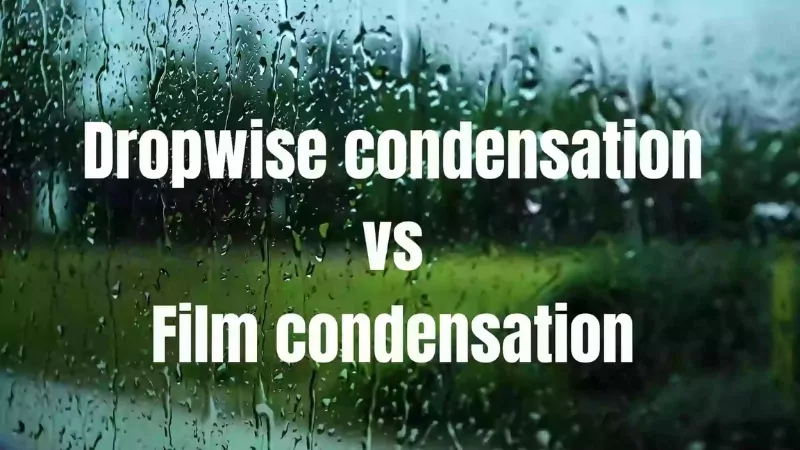The main difference between dropwise condensation vs film condensation is that in dropwise condensation, the vapours are condensed in the form of droplets on the surface of the condenser. while in filmwise condensation the vapours are condensed in the form of thin-film which wets the surface resulting in a lowering of the rate of heat transfer.

Let’s discuss each type of condensation process in brief.
Contents:
What is Dropwise condensation?
Dropwise condensation is the type of condensation process in which the vapours are condensed in the form of droplets on the surface.
The droplets are of different sizes and these droplets glide down from the surface and doesn’t form any insulating layer on the surface of the condenser.
As in dropwise condensation, the condensate never wets the surface, the overall heat transfer coefficient is higher in comparison with filmwise condensation.
The overall heat transfer coefficient in the case of dropwise condensation is around 10 times larger than in the case of filmwise condensation
For the dropwise condensation the surface should be highly polished.
While in some cases the promoter materials are used to promote dropwise condensation, Some of the promoters are added into the vapours while some promoters materials are hydrophobic impurities applied in the form of a coating on a heat transfer surface of condenser but this promoter becomes ineffective after some time because of oxidation and fouling.
What is Filmwise condensation?
Filmwise condensation is the type of condensation process in which the vapours are condensed in the form of a layer or film on the surface.
In the filmwise condensation process, the condensate material wets the surface of the condenser body therefore it adds extra resistance for the transfer of heat.
The overall heat transfer coefficient is less in the case of filmwise condensation, because of this the rate of condensation is also lower for filmwise condensation.
As the rate of condensation is lower, the equipment based on filmwise condensation is generally larger in size than equipment with dropwise condensation.
Dropwise condensation vs film condensation
| Sr. No. | Film condensation | Dropwise condensation |
|---|---|---|
| 1 | The liquid condensates are deposited in the form of a film or layer. | The liquid contents are deposited in the form of droplets of varying sizes. |
| 2 | The condensate wets the surface. | It never wets the surface. |
| 3 | The film or layer deposited works as insulation by adding extra resistance for heat transfer. | The droplets never wet the surface hence it never acts as insulation. |
| 4 | The overall heat transfer coefficient is lower. | The overall heat transfer coefficient is up to 10 times larger than in filmwise condensation. |
| 5 | The rate of condensation is lower. | The rate of condensation is higher. |
| 6 | The filmwise condensation occurs on less polished and uncontaminated surfaces. | The dropwise condensation requires a highly polished surface or the surface with promoters coating. |
| 7 | The size of the equipment for filmwise condensation is larger for the unit rate of condensation. | The equipment is comparatively smaller in size for the unit rate of condensation. |
Read also: